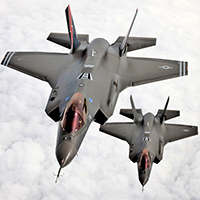A close-up look at the F-35A

The U.S. Air Force declared its first squadron of fifth-generation fighter jets, the F-35A Lightning II, combat ready earlier in August.
This remarkably advanced and powerful single-seat, single-engine fighter features advanced situational awareness, stealth, speeds of about 1,200 mph and much, much more – and it’s designed to be capable of a range of missions with just one aircraft.
The next-gen jet is designed to strike highly-defended targets anywhere on Earth and provide the U.S. military with an aircraft that can fly into enemy space and attack with precision weapons at long ranges— without ever being detected.
The 34th Fighter Squadron of the 388th Fighter Wing, based at Hill Air Force Base, Utah, is the service’s first operational F-35A squadron. To reach the Initial Operational Capability milestone, the base needed at least twelve combat-ready jets capable of global deployment for missions involving basic close-air support, air interdiction, and limited suppression and destruction of enemy air defense.
During the final few weeks of testing, I had the chance to visit, spend time with the squadron, and take a close look at the F-35A.
Fighter pilot Captain James Schmidt, of the USAF 388th Fighter Wing, gave me a thorough and detailed overview as we walked around the aircraft.
Stealth and design
What is 5th-generation stealth? The F-35 can go where legacy aircraft cannot.
Lockheed Martin’s F-35 Lightning II is a 5th-generation stealth fighter developed to safely penetrate areas without enemy radar seeing it— an enhanced degree of “invisibility” that the 4th-generation cannot achieve.
The F-35’s advanced stealth capability, called Very Low Observable (VLO) stealth, is achieved through advances that work to dramatically reduce detection by enemy aircraft and defense systems.
“So what makes the F-35 so unique and so effective is its stealth capabilities,” Schmidt said. “And that’s just one of the things that makes the F-35 unique.”
Stealth was built into this aircraft from the very start. Walking around the aircraft, Schmidt broke down some of the stealth features.
“You notice the shape of the aircraft. You notice how the doors have angles,” he said. “You’ll notice the lining of the wings and how the engine is buried in a curved inlet. All of these things. The special radar absorbing material that’s put on the jet— what we would call RAM— all of these things give the jet the ability able to evade modern-day radars.”
“When people ask us where do we see this jet? I see this 2050 and beyond,” Schmidt added. “It’s the jet that we’re going to need, the multirole platform to complement the F-22 and B-2 as well as we continue in today’s contested environment.”